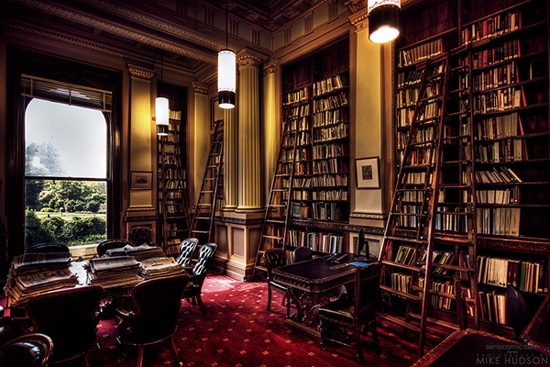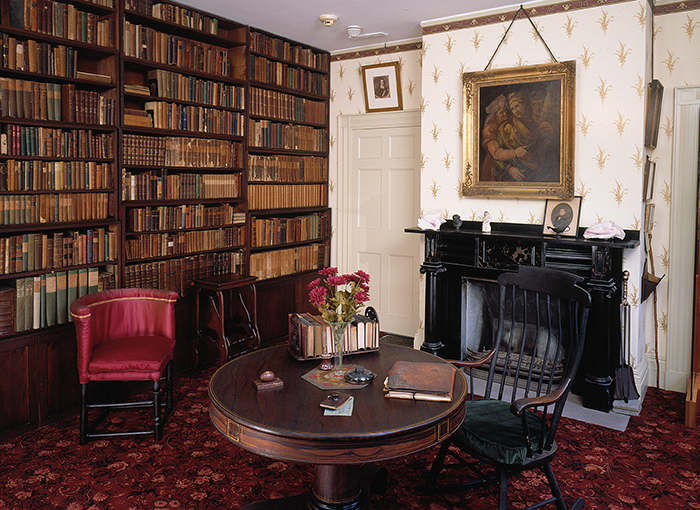They're made of oak, beautifully trimmed, 16 running feet of shelves along the wall, 9 feet high from floor to ceiling. We have natural chestnut and/or oak trim throughout the house, around all of the windows and doors (in every room but the renovated bathroom and kitchen). I chose a dark cranberry color for the walls in the library, and later he built me a library table. I bought an old Underwood manual typewriter to put on the table. It's my favorite room in the house. I have a section of signed, first editions. There's a section of cookbooks. We have the rest of the books sorted by category: fiction, motorcycles, gardening, home/how-to, health, literacy, Shakespeare, coffee table books. There's a set of three glass shelves in the center, with a spotlight I can turn on, to feature my Depression glass and a few collectibles and photos from our families.
The front end of the room has two windows facing the street. This is where I've put my Christmas tree every year but one since we've been in the house. I chose shimmery gold drapes which surprisingly look wonderful with the cranberry walls and natural trim. I leave my icicle lights up year-round in the windows, although I don't turn them on except during the holiday season.
And yes, I know I have to straighten out my shelves; they're too messy! (see next paragraph)
I have a library. In my house. Which you might think would ensure a place for every book and every book in its place. But no. I have too many books to fit in the library! Besides, I'm a firm believer that there should be books in every room. Books make a house a home. You learn from them. You love them. You share them. You live them. You experience them. You touch them and feel them and smell them. Well, you do if you're a reader like I am.
I would not be me without books. My mini-autobiography on our work intranet starts like this: "Ask me to describe myself in two words and I'd say, "I read." I am always reading at least two or three books at the same time." I've learned from my books, I've grown through my books, I've improved through my books. They're a part of me and always will be. I'd rather read than do almost anything else!
In today's Shelf Awareness PRO, Robert Gray writes about planning the bookshelves he'll be building in his home, and how they truly "make" a house a home... Here's his article (below). He's much more fluent than I could ever be but his article this morning sparked my thoughts about my library...
Shelf Awareness PRO - Friday | September 5, 2014 | Volume 2 | Issue 2335
Deeper Understanding
Robert Gray: When Bookshelves Make a House a Home
|
We are currently in the planning stages of an
ambitious bookcase-building project in the house we had rented since 2010 and
purchased last year. That means four years have passed during which our
substantial book collection, while readily accessible on temporary shelving
in the finished basement, has lived in relative exile. This will change soon
and our home will at last be fluent in the language of books.
Whenever I think of the power of bookshelves,
I recall a passage from Frederick Buechner's The Eyes of the Heart: A
Memoir of the Lost and Found: "The Magic Kingdom is my haven and
sanctuary, the place where I do my work, the place of my dreams and of my
dreaming.... It consists of the small room you enter through, where the
family archives are, the office, where my desk and writing paraphernalia are,
and the library, which is by far the largest room of the three. Its walls are
lined with ceiling-high shelves except where the windows are, and it is
divided roughly in half by shoulder-high shelves that jut out at right angles
from the others but with an eight-foot space between them so that it is still
one long room despite the dividers. There are such wonderful books in it that
I expect people to tremble with excitement, as I would, on entering it for
the first time, but few of them do so because they don't know or care enough
about books to have any idea what they are seeing."
It was not until early adolescence that I began to understand the influence bookshelves could have upon living space. Although my family did not collect books, my father built me a small bookcase. This modest addition altered my room, and life, forever. I've been surrounded by books since then. "Any home, especially one that has been lived in for quite a while, is a three-dimensional text," Alison Lurie writes in The Language of Houses, adding: "For many people, the home is a kind of sacred site, one that is chosen carefully and honored in memory; sometimes it may be revisited long after they have moved away." I think about the amazing book conversations Kathy Murphy--founder of the Pulpwood Queens Book Club (now with more than 550 chapters)--must have had in the Jefferson, Tex., house she is currently selling. Murphy recently told me that in 2000, she opened Beauty and the Book "on the bottom level of my house, out in the woods. Pulpwood Queens Book Club meetings were held in my home as we outgrew my tiny shop downstairs. I ran my shop and my book club there for years until I moved into an old house in town, which sold, then moved into the restored gas station." She has since relocated her business and book club to nearby Hawkins and will host the 15th annual Girlfriend Weekend in Nacogdoches this January.
Or consider legendary authors' homes. When we visit these
"sacred sites," I suspect that even those of us who profess not to
believe in ghosts may make an exception for the houses, and perhaps more so
the personal libraries, of writers who matter to us. I know a discernible
chill ran up my spine when I first visited Ralph Waldo Emerson's study, even
though it is housed at the Concord Museum.
Real estate probably complicates matters a bit. In recent months, the former residences of John Cheever and J.D. Salinger have hit the market, along with Judy Blume's Martha's Vineyard waterfront retreat and even the "house that inspired The Adventures of Pinocchio's author." But I'm much more intrigued by the volumes that were shelved along the walls of these sacred sites than the people who lived there. It is the books that haunt. "A building is an inanimate object, but it is not an inarticulate one," Lurie observes. Maybe that is why I also love bookshops located in old houses, where the current inventory forms a kind of biblio-palimpsest over decades of bookshelves owned by former residents. Wendy and Jack Welch founded Tales of the Lonesome Pine Bookshop, Big Stone Gap, Va., a few years ago in a century-old house. In The Little Bookstore of Big Stone Gap, her book chronicling their adventures and misadventures, Welch coined the term "B-space" to describe bookstores where "book-lined walls buffer against the world's bustling while browsing calms the soul and satisfies the mind." I think that will soon describe our house, too, now that the books are coming home once again. --Robert Gray, contributing editor (column archives available at Fresh Eyes Now) |
||||||||





After downsizing two times I have kept only the books I truly love and will read again. Also a smallish pile of ones yet to read.
ReplyDelete